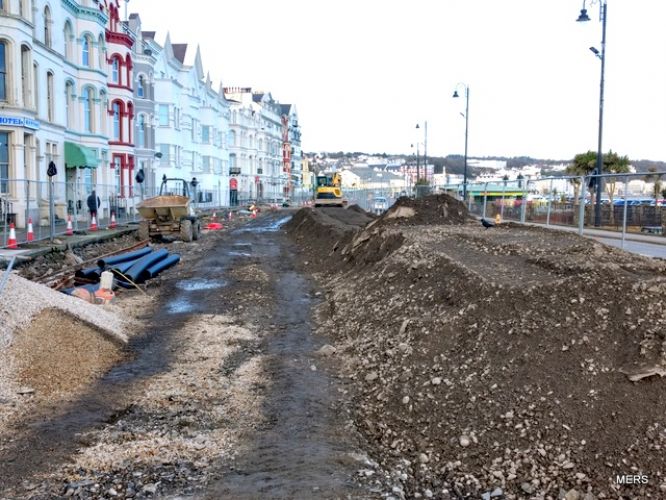'Design flaws in the multi-million pound Douglas promenade scheme have been blamed for cracks appearing in the concrete.'
“Concrete was used to create the red central tram corridor where cracking has appeared in the new surface.
The report by experts Robery Forensic Engineering, released following a Freedom of Information request, reveals that the cracks aren’t just on the surface but have penetrated the full depth of the concrete.
It concludes that the cracks are a direct result of the design, which saw concrete poured directly against the rails and with nothing separating it from the foundation slab beneath.
Asphalt could have been used instead, the report suggests.
It says there is a risk of de-icing salt and sea spray entering the cracks which ’may lead to reinforcement corrosion earlier than would be expected’.
Based on written information provided and without a site visit, the report was prepared for Auldyn Construction and looks at the engineering design of the scheme by Victoria Street- based Burroughs Stewart Associates (BSA) on behalf of the Manx government.
The RFE report finds: ’The cause of the cracking in the infill concrete is clearly and consistently caused by restraint to long-term drying shrinkage of the concrete.’
It says the cracking is consistent with ’excessive’ restraint to concrete drying shrinkage, which occurs principally in the first few months after casting.
RFE says that BSA’s design does not follow the common approach to ’rail-in-road’ construction in which the rail is isolated from concrete infill.
The problems arose with the concrete being cast directly onto the existing structural track bed slab, without the use of polythene separation membrane; and directly against rails with no means of preventing adhesion, the report concludes.
RFE explains: ’Rail and tram projects commonly use a soft encapsulation system around the rail, which may or may not include a clip arrangement to hold the rail in place.
’The encapsulation prevents direct contact between the rail clip arrangement and the concrete infill.’
But it says: ’To prevent cracking, an encapsulation system should have been used around the rails to provide a flat surface against which the concrete was cast, as is commonly used on light rails and tram projects where rails are set in the highway.’ It cites a typical encapsulation system that uses a cork-based compound set into the concrete.
Documents provided by Auldyn show that the BSA design details the concrete being cast directly against the rail and rail clips, using the rail as framework for the infill concrete and ’no encapsulation is used or intended’.
The report, dated September 23, says: ’The design by BSA does not appear to address adequately the technical problems arising from its decision to cast concrete against the rails.’
alternative
It suggests as an alternative design, the surface could have been finished in hot rolled asphalt rather than coloured concrete - and been crack-free.
Core samples cut from the central corridor where cracking has occurred show that rather than being limited to the surface, cracking has developed ’to the full depth of the infill concrete’.
The report includes comments by the government which suggested contractors Auldyn were responsible for a number of issues.
They included no control over the concrete being supplied; no protection to newly-cast concrete left to bake in temperatures of 23C; control of concrete on site prior to starting pours and vibrating rollers not used to compact rail surfacing.
However, in each instance, RFE found that Auldyn had either acted correctly or that a design flaw was the issue.
The report notes that all concrete shrinks as it dries, with 40% to 80% of this in the first 90 days. Any design needs to accommodate the effects of shrinkage.
It says that the cracks should be monitored a year after casting and decisions taken about what, if any, additional measures are required.
Another document released under a Freedom of Information request is a letter sent from director of highways Jeffrey Robinson to BSA the month before RFE’s report. In it he says the tram tracks ’don’t meet the expected and required standards’ and blames faults in design or construction or a combination of both.
He wrote: ’The cracked concrete is aesthetically unsatisfactory but is also a risk to the long-term durability of the tram corridor.’
Mr Robinson said a recent design change to introduce anti-cracking mesh reinforcement had failed to completely alleviate the problem, and he said this suggested that shrinkage cracking was not the cause.
He makes it clear that the DoI wants to work with BSA while also stating ’this is an issue for BSA, as the rail designer, to resolve’. He goes on to state that ’this is a matter for which BSA are responsible’.
Mr Robinson added: ’Should the current investigations determine that the issues outlined above are the result of a design failure it is appropriate to advise that the cost implications of any design changes will rest with BSA and that the cost of any remedial work that is required on concrete already laid and the cost of project delays are at BSA’s risk.
’I am sorry that this letter may seem harsh on a project where we remain committed to working together, but it is important that there is no misunderstanding moving forward.’
A separate document, dated June 14 this year, reveal that
further damage was caused when a diesel powered works tram, pictured driven by
capital project manager Ian Longworth, was used to test the track. “
It notes: ’Areas of the finished surfacing where the concrete was proud of the adjacent rail have been damaged when tram no.34 was used to test the rail.’
